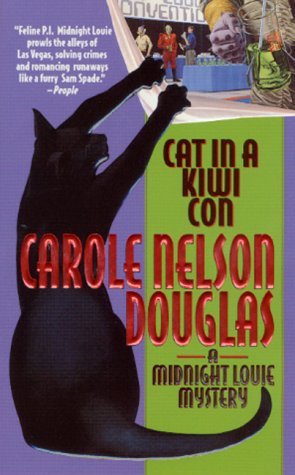 No’am Newman wrote this for us.
No’am Newman wrote this for us.
First, the facts: this is the fourteenth in a series of mystery books written about a cat called Midnight Louie. Some of the others have alliterative names such as Cat in a Diamond Dazzle or Cat in a Flamingo Fedora, whereas others forego this literary device and have slightly more mundane names, such as Cat on a Blue Monday, or “Cat in an Indigo Mood.” What is clear is that Nelson Douglas is slowly working through the alphabet with her titles, each letter also being a different colour (so that each book’s cover will show Midnight Louie in a different light).
Second, the impressions: if Cat in a Kiwi Con is a mystery story, then Zen and the art of motorcycle maintenance is indeed about motorcycle maintenance. There’s very little mystery in this book; there may be a murder or two, but this book is hardly a whodunit.
I admit in my weaker moments to enjoying detective fiction; this tends more to the literary pole of British detectives, rather than their hard-boiled American counterparts, so I was looking forward to reading about a feline detective. Out of the sixty chapters in the book, maybe ten at most are narrated by Midnight Louie (these are typeset in a different font), and outside of these chapters, he barely makes an appearance, not that anyone seems to relate to him. The chapters that are written from his point of view have a great deal of wit, so it’s a shame that Louie doesn’t take a more active part in the story.
What we have here is not a mystery story, but rather a document of the Naughty Noughties. It starts off disconcertingly by giving brief insights into the lives of five people (and a cat) who will appear throughout the book; each person appears abruptly, without introduction, and apparently without connection, although it transpires that all of them have appeared in the other books of this series. Throughout the book there are hints of earlier stories, which on the one hand contribute to giving the entire series a consistent feel, but on the other hand make it confusing for the first-time reader. Dr Watson used to do this as well, but more often he used to refer to non-documented cases, and only rarely did he refer to another Holmes story.
The major characters are Temple Barr, twenty-something owner of Midnight Louie who apparently does something connected with public relations (but is never seen working at this during the book); Carmen Molina, police lieutenant in homicide, and her daughter Mariah; ex-priest turned radio talk show presenter Matt Devine, and ex-magician Max Kinsella, who has been working underground with the FBI against terrorists. Note that all the characters’ names (bar Temple) begin with ‘M’: this is intentional.
Most of the action takes place in a science fiction convention (the eponymous “Kiwi Con”), which allows several of the characters to dress up and make themselves unrecognisable, thus adding to the general confusion. The days spent in the convention allow the author many social observations about role-playing people and the depths of their obsessions. Whilst it may be entertaining and witty, it isn’t moving the story along.
Most fiction tends to revolve around people who suddenly have a problem and what they do to resolve that problem. The characters portrayed in this book think that they have a problem, but the problem itself is never spelled out clearly, and whilst their actions (from their point of view) are concerned with solving that problem, the reader can’t see them actually doing anything to resolve it. One of the three deaths that occur during the book happens during the convention, and it seems like an afterthought and has little to do with the characters that we follow. One of the others appears to be connected to the ongoing story, and the third is left unexplained.
After having read the book, I started looking for Midnight Louie on the Internet. This was very easy, as the book has an epilog mentioning Louie’s Web site. This is a very garish page which I suspect was developed by Carole Nelson Douglas herself; it also takes a long time to load! There is a link to an interview in Crescent Blues, which gives a good background into the Louie series, and explains away some of my puzzlement.
For example, Nelson Douglas says, “The Midnight Louie series itself is constructed like a three-year television series, such as The X-Files, with an ongoing back story that involves the main four characters’ private and past lives, and episodic front stories that involve different characters and crime milieus in each book. Because I introduced an internal alphabet with the third book title (Cat on a Blue Monday), the entire series will number 27 books, with three back story arcs of nine books each.” This may be so, but it means that one really has to begin with the first book in order to get a complete picture; starting with the fourteenth means that one only gets a partial picture, and thus explains my confusion.
There’s one passage in the book which I have to quote: “On the other hand, a novel dealt with characters and issues, and no matter the genre, the writer could always invest the material with underlying significance. That was the beauty of a book.” I quite agree, but unfortunately the characters in this book are shallow, and there doesn’t seem to be much underlying significance to the material.
(Forge, 2000)
